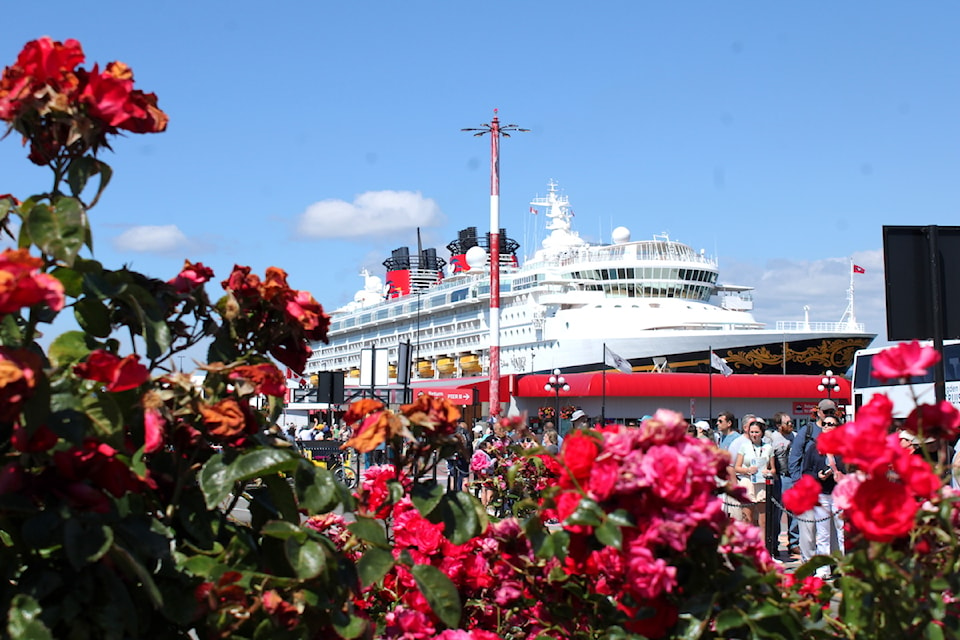Like a growing number of ports, new infrastructure coming to Ogden Point will look to reduce the air pollution of docked ships by allowing them to plug into the local grid.
As the owner and operator of several major assets along the capital's waterfront, the Greater Victoria Harbour Authority (GVHA) has envisioned adding shore power to several berths at Ogden Point's deep-water terminal, which would allow cruise ships to turn off their engines as they draw clean electricity from the port.
But the increased demand for shore power has led to rising costs for getting that technology made and delivered. That trend comes as a number of other electrification options – like methanol-fuelled charging stations and barge-based battery systems – have recently entered the commercial market. That's prompted the harbour authority to take another look to see if there's a more cost-effective option that may offer similar greenhouse gas emission reductions.
“We figured doing that extra little work to make sure we’re making the smart choice for the long term is really really important,” GVHA CEO Robert Lewis-Manning said in an interview.
While some alternatives present cost savings, several are also portable systems. Having movable options could be more efficient than having shore power at multiple berths because Ogden's three deep-water docking points aren't always full, Lewis-Manning said. Tuesday (July 23) offered an example as there were two cruise ships set to arrive in Victoria, but their docking times didn't overlap.
The CEO added that cruise ships are moving to zero-emission fuels over the next 20 to 30 years, so the harbour authority wants to ensure it doesn't install shore power only for it to become outdated technology.
The shore power project received $9 million in funding from the province and was set to be operational by 2027. Lewis-Manning said the consideration of other options will mean ships will likely have to wait one extra year until they can start tapping into power at Ogden Point.
"We think it’s worth the slight delay in order to see if there’s a better option,” he said, adding cost savings will benefit GVHA's various other projects, such as maintenance to the Inner Harbour's lower causeway.
While being able to turn off their engines and plug into clean-electricity could help cruise liners quell their pollution when they're docked, environmentalists say lax regulations continue to impact B.C.'s coastal areas.
After the Canadian government brought in new measures last year, a recent Stand.earth report criticized the feds for extending that interim order without bringing in additional requirements.
That 2023 order restricted – with several exemptions – where cruise ships can release sewage and greywater, but it didn't address devices that permit the continued use of heavy fuel oil, despite more stringent international rules.
“It enables a cheap and dirty fossil fuel that otherwise would’ve been banned because of air pollution regulations,” Anna Barford, Stand.earth's Canada shipping campaigner, said in an interview.
The International Maritime Organization in 2020 limited the allowable sulphur content of marine fuels in an aim to reduce particulate matter and other kinds of emissions. To comply with those requirements, ships are able to use systems commonly known as scrubbers, which use seawater to rinse exhaust gases before some pollutants are separated from "washwater," which is then discharged into the ocean.
That dumped washwater impacts coastal communities and marine species, but Canada lags behind other countries that have banned the scrubber use or are making cruise liners invest in cleaner fuels to align with the new emission rules, Barford said. She also points to a document prepared by Environment and Climate Change Canada in April of this year that said "the use of scrubbers in Canadian waters has increased rapidly since 2019."
That document states that the use of scrubbers in Canadian waters was relatively rare before 2018, but ships equipped with them discharged over 88 million tonnes of washwater on Canada’s Pacific coast in 2022. That figure was double the 2019 total. The number of vessels with scrubbers off B.C.'s coast grew from 125 to 466 in those three years, with cruise ship being the most prominent users.
“This is a waste stream that is incredibly toxic and a problem that is growing rapidly. We need to be acting before we’re allowing permanent damage from fossil fuel waste to our marine ecosystems,” Barford said.
Stand.earth hopes Transport Canada prohibits scrubber use and further regulates the sewage and greywater from cruise ships by not allowing discharges in protected areas and eliminating current exemptions that allow dumping closer to shore.
Several questions were posed to Transport Canada last week. The agency said it was working on a response but has yet to provide one. The Cruise Lines International Association didn't respond to questions about how the industry its pollution in B.C. waters.
Barford added that regulations should be coupled with better monitoring and enforcement as the cruise industry is used to operating out of sight. She's also concerned that ships using shore power will use those banked emission savings to burn more fuel once they're back in open waters. That could see ships travelling faster, which could increase the risk of whale strikes, the campaigner said.
The province recently announced $3 billion over the next decade for electricity infrastructure on Vancouver Island. In preparation for power options at the harbour, BC Hydro said improvements that will run between Ogden Point and a Victoria substation are still in the design phase.
“We want to electrify as much of the province as we can to make sure that we can provide a clean reliable source of energy, with less reliance on fossil fuels,” BC Hydro spokesperson Ted Olynyk said.
With an aim to have sustainability a guiding principle of Victoria's bustling waterways, Lewis-Manning said the GVHA will also be working to restore the harbour’s ecology. Those efforts will include improving local water and air quality, and will support the harbour's social and cultural values.



